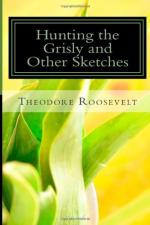If cowboys come across a cougar in open ground they invariably chase and try to rope it—as indeed they do with any wild animal. I have known several instances of cougars being roped in this way; in one the animal was brought into camp alive by two strapping cowpunchers.
The cougar sometimes stalks its prey, and sometimes lies in wait for it beside a game-trail or drinking pool—very rarely indeed does it crouch on the limb of a tree. When excited by the presence of game it is sometimes very bold. Willis once fired at some bighorn sheep, on a steep mountain-side; he missed, and immediately after his shot, a cougar made a dash into the midst of the flying band, in hopes to secure a victim. The cougar roams over long distances, and often changes its hunting ground, perhaps remaining in one place two or three months, until the game is exhausted, and then shifting to another. When it does not lie in wait it usually spends most of the night, winter and summer, in prowling restlessly around the places where it thinks it may come across prey, and it will patiently follow an animal’s trail. There is no kind of game, save the full-grown grisly and buffalo, which it does not at times assail and master. It readily snaps up grisly cubs or buffalo calves; and in at least one instance, I have know of it springing on, slaying, and eating a full-grown wolf. I presume the latter was taken by surprise. On the other hand, the cougar itself has to fear the big timber wolves when maddened by the winter hunger and gathered in small parties; while a large grisly would of course be an overmatch for it twice over, though its superior agility puts it beyond the grisly’s power to harm it, unless by some unlucky chance taken in a cave. Nor could a cougar overcome a bull moose, or a bull elk either, if the latter’s horns were grown, save by taking it unawares. By choice, with such big game, its victims are the cows and young. The prong-horn rarely comes within reach of its spring; but it is the dreaded enemy of bighorn, white goat, and every kind of deer, while it also preys on all the smaller beasts, such as foxes, coons, rabbits, beavers, and even gophers, rats, and mice. It sometimes makes a thorny meal of the porcupine, and if sufficiently hungry attacks and eats its smaller cousin the lynx. It is not a brave animal; nor does it run its prey down in open chase. It always makes its attacks by stealth, and if possible from behind, and relies on two or three tremendous springs to bring it on the doomed creature’s back. It uses its claws as well as its teeth in holding and killing the prey. If possible it always seizes a large animal by the throat, whereas the wolf’s point of attack is more often the haunch or flank. Small deer or sheep it will often knock over and kill, merely using its big paws; sometimes it breaks their necks. It has a small head compared to the jaguar, and its bite is much less dangerous. Hence, as compared to its larger and bolder relative, it places more trust in its claws and less in its teeth.




